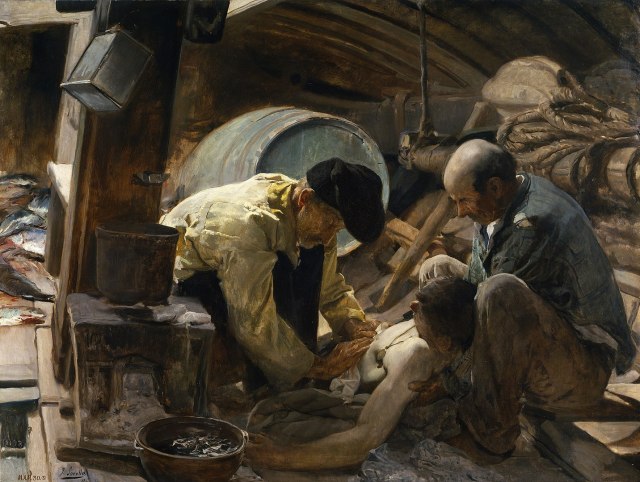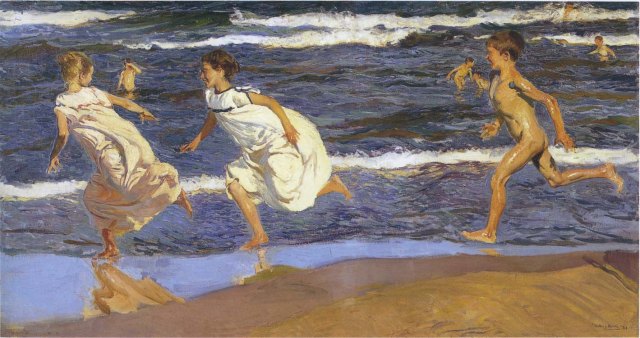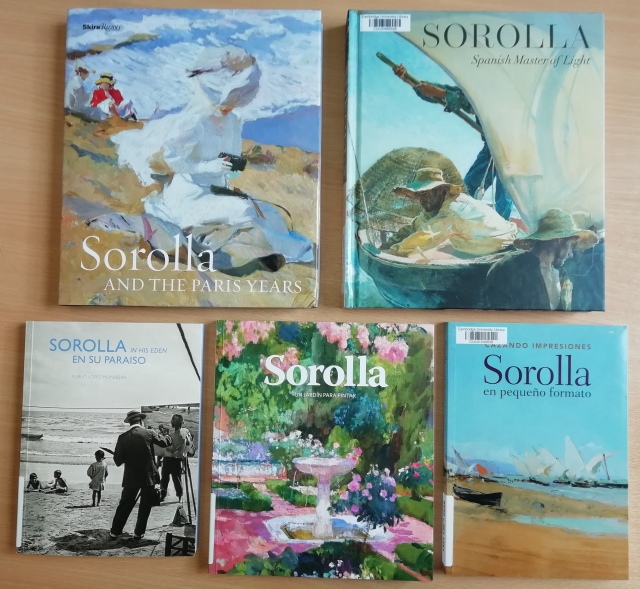The exhibition Sorolla: Spanish master of light (S950.a.201.6770) that inspired this post is coming to an end at the National Gallery (London) on 7 July, but will open at the National Gallery of Ireland in Dublin between 10 August and 3 November.

Although probably not known to the English-speaking educated public, Sorolla was the most internationally well-known Spanish artist of his time. A painter with a style close to impressionism, and without any doubt, a master at capturing light.
Joaquín Sorolla y Bastida (1863-1923) was born in Valencia, the son of a tradesman, but became an orphan at a young age. Joaquín and his sister were taken under the care of their aunt and uncle, who was a locksmith. Sorolla showed an early interest in painting. He started taking drawing classes in 1874, later followed by studies at the Fine arts school in Valencia. With the support of the photographer Antonio García Peris (see S950.c.201.1204), his future father-in-law, he was able to set up his first studio.

1881 was a significant year for him: he went to Madrid for the first time, where he visited the Museo del Prado, and presented three works at the National Fine Arts exhibition. A year later, he returned to Madrid and copied the works by the Spanish master Diego Velázquez that had made an impression on him during his first visit. In the following years he won awards in regional and national exhibitions and gained a grant for continuing his training at Rome (1885-1888). He married Clotilde García del Castillo, daughter of his benefactor. In 1889 he visited the Universal Exhibition in Paris, setting up soon thereafter a studio in Madrid. Sorolla’s paintings started to be accepted for international exhibitions (Paris, Berlin, Chicago, Vienna, Venice, and more) attracting success and several medals and awards. For instance, he presented various works at the Universal Exhibition (Paris) in 1900, winning jointly with other artists the Grand Prix. In addition, he frequently participated in the Salons organised by the Society of French Artists. A recent exhibition explored the impact that his time in Paris had on his career (S950.a.201.6769).

Sorolla was a prolific and versatile painter, mastering many genres ranging from portraits and landscape painting to historical paintings and genre painting often with an ethnographic focus. For some time he did ‘social painting’, his canvases telling the stories of disfavoured social groups of his time, such as fishermen from his region and low-paid workers. A great example of this type of painting is And they still say fish is expensive!, depicting a young wounded mariner attended by two old men. This painting was presented at the Munich International Exhibition of 1894. His most famous works are the coastal scenes. Sorolla excelled in representing Mediterranean light. His canvases were painted with impressionistic brushstrokes and are full of colour and light. An excellent example is Running along the beach, Valencia (1908). Finally, we should mention his beautiful garden scenes and landscapes (see gallery below).

By the beginning of the 20th century Sorolla already was a cosmopolitan painter, popular enough to receive commissions for royal portraits: he painted the portraits of the young King Alfonso XIII of Spain, his consort Queen Victoria Eugenia of Battenberg (granddaughter of Queen Victoria) and Princess Beatrice of Battenberg, sister of King Edward VII. The last is the only painting by Sorolla in a British national collection (National Portrait Gallery). After a first successful individual exhibition in Paris in 1906, a vast exhibition of his work was organised at The Grafton Galleries in London two years later. The exhibition was sponsored by his friend, the renowned painter John Singer Sargent (Sorolla was often compared with him: see S950.a.200.2589), and patronised by the king and queen of Spain.
Sorolla was not happy with the exhibition, nor with the grandiloquent statements of the pre-publicity (presenting him as “world’s greatest living painter”), nor with the exhibition catalogue. The exhibition resulted in few sales and, during his London stay, he only received one portrait commission, the already mentioned portrait of Princess Beatrice. Despite his previous achievements in Europe, he remained relatively unknown in Britain. However, his London stay did have a significant positive outcome: the proposal of an even bigger exhibition in New York to be put on by the American Hispanist and philanthropist Archer M. Huntington (see C216.c.680), founder of the Hispanic Society of America, who turned out to be a crucial sponsor for the following years.
In 1909 the Hispanic Society of America (N.Y.) held his solo exhibition, displaying 356 of his works, with an attendance of 160,000 visitors (see photo below). Two hundred of these works went on to be exhibited in the Fine Arts Academy in Buffalo the same year. Sorolla then sold 195 works for a total of 181,760 dollars.
Thanks to Huntington, Sorolla received in 1911 a major commission from the Hispanic Society of America, to paint Visions of Spain, an ambitious cycle of 14 panels showing a selection of regions of Spain, for the library of the society. The work was due to be completed within five years, but it was not finished until July 1919. During the next few years, the artist travelled widely across Spain, working in situ in order to represent the different regions with an ethnographic taste. The resulting cycle can still be seen at the Hispanic Society of America. Several smaller format preparatory works of this cycle from the Sorolla Museum in Madrid are included in the current National Gallery exhibition, like Types of Salamanca.
Strongly connected with Spanish painting tradition, Sorolla was a master at interpreting Velázquez’ works; we can see the influence of Velázquez in his compositions, particularly in some of his portraits. For example, that influence is clear in The family, where he is represented on a mirror in the background in a similar way as Velázquez depicted himself in his masterpiece Las Meninas. Another portrait worth mentioning is the one of his friend and landscape painter Aureliano de Beruete.
Sorolla suffered a stroke in 1920 and could no longer paint. While we can see an evolution in his style over the course of his career, Sorolla remained loyal to naturalistic art. By the time of his death in August 1923, art conventions were undergoing seismic changes and avant-garde artists were moving into experimental non-figurative art. These shifts explain why after Sorolla’s death, he was soon forgotten, and only celebrated internationally in exhibitions in much more recent years (see further reading at the end).

The National Gallery has paid a major tribute to the artist by organising this comprehensive exhibition, gathering many paintings brought from overseas, coming specially from Spain and the USA, particularly with many loans from the Sorolla Museum (Madrid). This is only the second individual exhibition of Sorolla in the UK, following the one of 1908, and the first in Ireland.
We end by quoting Gabriele Finaldi, director of the National Gallery:
“Sorolla is the painter par excellence of Mediterranean sunlight and it is impossible to stand in front of his pictures and not be impressed by the scale of his ambition, by the bravura of the brushwork, the beauty of his landscapes, beach and garden scenes, and by the sheer vital energy that throbs within the oeuvre.” (p. 6, S950.a.201.6770)
Manuel del Campo
Further reading
-Colomer, José Luis; Pons-Sorolla, Blanca; Roglán, Mark A. (eds.) Sorolla in America: friends and patrons. Dallas: Meadows museum, 2015. S950.a.201.4266
-Díez, Jose Luis; Barón, Javier (eds). Joaquín Sorolla: 1863-1923. London: Thames & Hudson, 2009. S950.a.200.2919
-Facundo, Tomás (ed.) Epistolarios de Joaquín Sorolla. 3 v. Rubí: Anthropos, 2007-2009. 405:43.c.200.36-; available online
–Fiesta y color: la mirada etnográfica de Sorolla. Madrid: Fundación Museo Sorolla, 2013. 2014.11.333
-López Modéjar, Publio. Sorolla en su paraíso: álbum fotográfico del pintor. Madrid: Fundación Sorolla, 2017. In Spanish and English. S950.c.201.1204.
-Menéndez Robles, María Luisa (ed.). Joaquín Sorolla: técnica artística. Madrid: Tecnos, 2015. C211.c.664
-Pons Sorolla, Blanca. Sorolla: obras maestras. Marid: El Viso, 2012. S950.a.201.1281
-Id.; López Fernández, María. Sorolla and the Paris years. New York: Skira Rizzoli, 2016. S950.a.201.6769
-Id. Cazando impresiones: Sorolla en pequeño formato. Madrid: El Viso, 2019. S950.c.201.1251
–Sargent / Sorolla. Madrid: Museo Thyssen-Bornemisza, 2006. S950.a.200.2589
–Sorolla: Spanish master of light. London: National Gallery, 2019. S950.a.201.6770
–Sorolla: un jardín para pintar. Madrid: El Viso, 2017. S950.c.201.1250
–Sorolla y la Hispanic Society: una visión de la España de entresiglos. Madrid: Museo Thyssen-Bornemisza, 1998. S405:43.a.9.123


Great post 🙂
Thank you! I’m glad you like it.